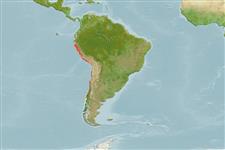Common names from other countries
Environment: milieu / climate zone / depth range / distribution range
Ekologi
; kisaran kedalaman 0 - 500 m (Ref. 356). Tropical, preferred 20°C (Ref. 107945); 5°S - 42°S, 81°W - 70°W (Ref. 106891)
Southeast Pacific: From Paita, Peru to Chiloé, Chile. Tropical to subtropical.
Length at first maturity / Size / Weight / umur
Maturity: Lm ? range ? - ? cm Max length : 12.0 cm ShL jantan/; (Ref. 356)
Found in shallow bays (Ref. 106891). Inhabits sedimentary grounds in sheltered areas at depths from 5 to 40 m (Ref. 106862).
Life cycle and mating behavior
Kematangan | Reproduksi, perkembang biakan | Pemijahan | telur-telur | Fecundity | Larva
Life cycle: Embryos develop into free-swimming trocophore larvae, succeeded by the bivalve veliger, resembling a miniature clam (Ref. 833). Spawning occurs year-round but mainly during spring and autumn (Ref. 106788).
rujukan utama
Acuan | Koordinator | mitra
SAUP Database. 2006. (Ref. 356)
Status IUCN Red List (Ref. 130435)
status CITES (Ref. 108899)
Not Evaluated
Not Evaluated
penggunaan manusia
Perikanan: komersial; Budidaya air: komersial
FAO - Budidaya air: production; Perikanan: landings | FishSource | Sea Around Us
Alat, peralatan
Sumber internet
Estimates based on models
Daya lenting
Tinggi, Waktu penggandaan populasi minimum kurang dari 15 bulan (K=1.99-2.88).
keancaman
Low vulnerability (10 of 100).
